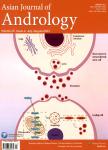Interaction between basigin and monocarboxylate transporter 2 in the mouse testes and spermatozoa
Interaction between basigin and monocarboxylate transporter 2 in the mouse testes and spermatozoa作者机构:Department of Anatomy and Developmental Biology Graduate School of Medicine Chiba University Chiba Japan Department of Cell Biology Research Institute for Microbia Diseases Osaka University Osaka Japan Laboratory of Histology and Cytology Department of Anatomy Graduate School of Medicine Hokkaido University Hokkaido Japan
出 版 物:《Asian Journal of Andrology》 (亚洲男性学杂志(英文版))
年 卷 期:2016年第18卷第4期
页 面:600-606页
核心收录:
学科分类:0710[理学-生物学] 071010[理学-生物化学与分子生物学] 1002[医学-临床医学] 07[理学] 0905[农学-畜牧学] 09[农学] 090501[农学-动物遗传育种与繁殖]
基 金:supported in part by grant from the Japan Society for the Promotion of Science to Dr. Mamiko Maekawa
主 题:basigin monocarboxylate transporter sperm maturation spermatogenesis spermatozoa testis
摘 要:Basigin is a member of the immunoglobulin superfamily and plays various important roles in biological events including spermatogenesis. To examine the basigin molecular variants during spermatogenesis and sperm maturation in the mouse, immunoprecipitated basigin samples from testis and epididymal spermatozoa were analyzed by liquid chromatography-mass spectrometry/mass spectrometry (LC-MS/MS). The results demonstrated that basigin molecules from the testis and spermatozoa were separable into two major bands and that the differences in the molecular sizes were possibly because of an endoproteolytic cleavage. Since basigin is known to be a chaperone for the monocarboxylate transporter 1 (MCT1), the localization of basigin, MCT1 and MCT2 was examined during postnatal testicular development. Immunohistochemical studies showed different expression patterns of MCT1 and MCT2. MCT1 was localized on the surface of spermatogonia, spermatocytes, and spermatids. In contrast, MCT2 appeared on the principal piece of spermatozoa in the testis, where basigin was also observed. In mature epididymal spermatozoa, MCT2 was located on the midpiece, where basigin co-localized with MCT2 but not with MCT1. Furthermore, MCT2 was immunoprecipitated with basigin in mouse testes and sperm. These results suggest that basigin has a functional role as a binding partner with MCT2 in testicular and epididymal spermatozoa.



